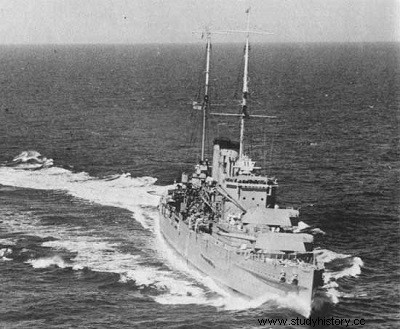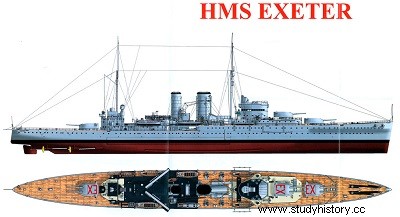
The first British cruisers studied after the First World War were the "Counties very different from the precedents which were the first "Washington" cruisers. Because of their high freeboard and the antique look of their three funnels, but also because the British did not cheat displacement as blatantly as most other naval powers, ships of this important series were considered to be inferior to their foreign contemporaries. The "Counties", however, had to prove that they were excellent warships; their twin 203mm mounts were powerful and efficient, their speed and endurance met most requirements and, despite a tendency to roll side to side, they were good seagoing vessels. Their protection was also adequate with cargo holds ammunition armored as half of their engine and evaporator apparatus.
Within the framework of the treaties, the “Counties” are all cataloged as class “A” cruisers, but there were also clauses defining a class “B”, armed with 203 mm, a sort of “economical” version. The length and width of the original plans were reduced, and three 203 mm turrets were installed instead of four. The freeboard generally became lower and the continuous Counties deck gave way to a two-tier deck; the three chimneys were replaced by only two.
Only two ships of this type were built, the York and then the Exeter. The second differed slightly from the first:its bridge was lower, its chimneys vertical, and it carried two fixed oblique catapults, behind the chimneys. At that time, great importance was attached to the aviation facilities of cruisers, which would indeed render great service, at the beginning of the war, to lone cruisers on ocean patrol.
Similarly Like the Counties and most British cruisers, Exeter had secondary 100 mm anti-aircraft artillery and 533 mm torpedo tubes. But it was probably his excellent protection that was his best asset during the famous engagement with Graf Spee; it allowed him to play his role to the limits of the possible in the tactical execution of the anti-corsair scheme developed by the Admiralty, before the conflict, to fight against pocket battleships.
After Exeter, Britain no longer began work on cruisers armed with 203 mm, mainly considering that the rapidity of fire and ease of maneuvering of 152 mm guns more than compensated for their lesser range, especially if the ship thus armed had protection resistant to 203 millimeter fire. Before leaving the British cruisers armed with 203 mm, it should however be noted that the shells fired by "Counties" caused fatal damage to two German battleships:the direction of fire of the Bismarck, put out of service, and the radar from Scharnhorst, shattered by a direct hit.

H.M.S. EXETER
Moving Washington , 8,390 t; fully loaded, 10,500 t
Length 175.20 m overall
Width 17.68 m
Average draft , 5.18 m
Propulsion 4 shaft lines, gear turbines, 80,000 hp, 32.25 knots
Protection
breastplate belt , 50-76 mm;
deck , 50 mm;
turrets, 35-50 mm
Artillery 6 x 203mm, 4 x 100mm AA; 2 pom-poms of two pounds
Tubes L.T. 6 × 533 mm torpedo tubes
Launched July 18, 1929 at the Devonport yards
